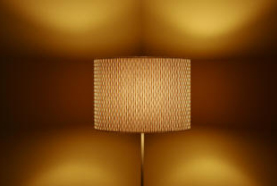From Gloom to Glow
 The secret is out -- lighting is the single most important element in decorating, dramatically improving the look and feel of any room. But with so many options out there, finding that right light may be a little easier said than done. Chances are, you’ve probably wondered, do I have the right sized fixture? How do I install it? How low do I hang it? Will it be too bright or just right?
The secret is out -- lighting is the single most important element in decorating, dramatically improving the look and feel of any room. But with so many options out there, finding that right light may be a little easier said than done. Chances are, you’ve probably wondered, do I have the right sized fixture? How do I install it? How low do I hang it? Will it be too bright or just right?
1. How can I achieve the proper illumination in a room?
There’s actually a proven formula for calculating the proper amount of light you’ll need, and it’s not difficult -- just some basic arithmetic.
Formula: Room Length x Room Width x 1.5 = Proper Amount of Watts to Light a Room
For example, let’s say, you have a 12x16-foot living room: 12x16x1.5 = 288 watts of lighting. Therefore, a five-light chandelier using 60-watt bulbs will provide sufficient light for the room. For more concentrated lighting over a task or work area such as a kitchen island, simply multiply the dimensions of the island by 2.5.
2. What size chandelier would best suit a foyer?
Always keep in mind that the bottom of the chandelier should be at least 7-feet from the floor. If there is a window above the front door, center the chandelier so it can be seen from outside. If the foyer is extra large, you may also want to include wall sconces for additional light.
To determine the chandelier’s width, simply add the dimensions together. For example, let’s say you have a 12x16-foot foyer: 12+16=28. Therefore, the foyer chandelier’s diameter should be approximately 28-inches in width.
3. What’s the best way to light a hallway?
There should be a light every 8 to10-feet. Either flush-mounts or semi-flush fixtures can be used depending on ceiling height.
4. What size chandelier should hang over my dining room table?
It’s best to choose one with a diameter equal to one half the width of the table. Here, as in the foyer, room dimensions dictate the width of the chandelier. Also, keep in mind that the bottom of the chandelier should be at least 2 1/2 feet above the table.
5. How do I light a dinette area?
Normally, a decorative pendant or a fixture with a down light will do the job. Use a dimmer to soften the light when entertaining and brighten the area for homework or hobby-related tasks. Again, the bottom of the pendant should be at least 2 1/2 feet above the table. Normally 100 watts of light is sufficient for these areas.
6. What’s the best way to light a bathroom?
Most bathrooms only have a light fixture above the mirror because that is where the single outlet box is usually placed. The problem: top-mounted lighting casts shadows down on the face, harshly accentuating flaws and making lines look deeper. If you want to see your true self, then you also need lighting on each side of your face. Use a fixture such as top-mounted lighting fixture that comes with matching mini pendant lights on each side and only needs a single outlet box to work.
7. When do I need portable lighting?
Besides adding a focal point, portable lights can provide extra light for tasks such as reading, homework and crafts and should be used when additional task light is needed. If you’re using a floor or desk lamp, the bottom of the lampshade should be approximately 42-inches from the floor’s surface. Desk lamps should be 16-inches above the work surface, and torchieres, used to light dark corners, should be 66 to 72-inches from the floor. Corners Collections can provide similar light but won’t take up floor space as the fixtures easily mount in a room’s corners. Feel a little more prepared? By using these tips as a guide, purchasing lighting should be a little easier.











